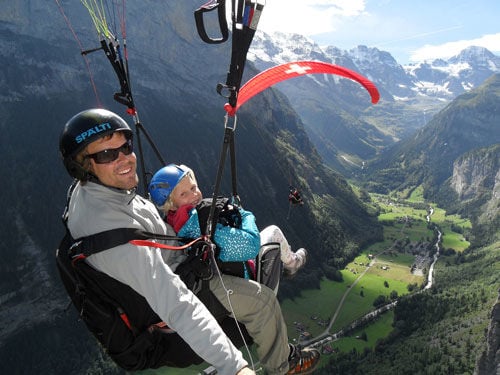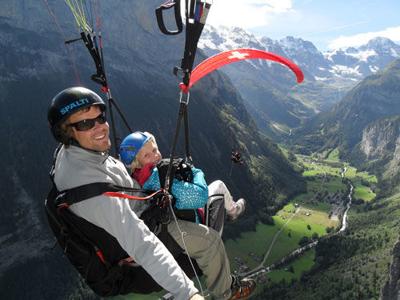You’ve probably seen them on your drive home, or from the beach, hovering above the shoreline like slow, silent hawks; dotting the sky with tiny slivers of neon pink, yellow and blue. They sometimes seem motionless, as if frozen in time, hanging from the sky like dabs of color on a painter’s canvas; or like parachutes, drifting safely and silently down to Earth. But they’re actually paragliders—and they're most likely on their way up.
Paragliders are similar to hang gliders, as they have no motor or any other means of propulsion. They rely solely on the power of wind current and thermal activity to lift and move them through the air. In fact, paragliders are one of the most basic forms of aircraft there is, built with little more than sailcloth, nylon and a set of Kevlar lines.
Overall, paragliders resemble—and are often mistaken for—parachutes. But unlike parachutes (which are designed to come down), paragliders are designed to go up. And instead of the traditional parachute harness (a simple set of chest and leg straps), paragliding harnesses are fashioned into small, adjustable seats, offering improved aerodynamics and greater comfort for long flights.
Paragliding is considered by many as one of the most thrilling and awe-inspiring activities in the world. Viewing the Earth’s colorful terrain from thousands of feet above, dangling from a set of strings and drifting through the air like a free-floating feather is so exhilarating, people often say it’s "better than sex."

Paragliding view from above
It may seem like a frightening feat to take on at first, but the stability and user-friendliness of the glider itself quickly eases such tensions, as it seems to lift you up as gently as an elevator, with no indication of any sudden drops or falling-from-the sky scenarios. In fact, paragliders are so buoyant and so stable that it’s usually much more of a challenge to bring them down than it is to keep them up, and most pilots learn to trust in their glider’s reliability rather quickly.
Paragliders are not just easy to pilot, they’re easy to pick up and get the hang of. With proper training, just about anyone can learn to paraglide, from children as young as 5 to seniors well into their 70’s. In fact, the largest age group amongst paragliders seems to be in the 40-60 range, making it one of the most favored sports for retirees and aging thrill-seekers.
As far as training goes, San Diego is great place to learn how to paraglide because of its distinctive cliff-side beaches (which happen to be prime for effortless free flight) and because of Torrey Pines Glider port, one of the most sought-after paragliding destinations in the world.
The glider port sits on top of the Torrey Pines Bluffs, overlooking Black’s Beach and the vast Pacific Ocean. It’s basically just a large, grassy slope used as a launch and landing zone for paraglider and hang glider pilots. On any given day—no matter what kind of weather—you’re sure to see dozens of eager pilots launching, landing, training and kiting; having a nice day out and lots of fun. In fact, many people go to the glider port just to see the sights and have a bite to eat.

Torrey Pines Glider Port
But most spectators can only watch for so long before they’re dying to try it themselves, and learning to paraglide is easy; you’ll just have to decide where to train. Torrey Pines offers full lessons, testing and pilot ratings, in addition to all the gear you’ll need to take flight. They also provide one of the finest paragliding sites in the world, perfect for training and beginning pilots.
There are also a number of paragliding instructors in San Diego that generally hold training classes at local, beginning-level paragliding sites or training areas. Either way, you can be fully trained to take your first flight or earn a pilot’s rating to fly regularly in as little as a few weeks.
So if you’re aching to get out and start doing something fun, relaxing and adventurous, head over to Torrey Pines Glider Port to mingle with some of the pilots and instructors; or go all out and take a tandem flight to experience it first-hand. But beware—if you’re anything like the other local air junkies, once you go up, you’ll never want to come down.





(0) comments
We welcome your comments
Log In
Post a comment as Guest
Keep it Clean. Please avoid obscene, vulgar, lewd, racist or sexually-oriented language.
PLEASE TURN OFF YOUR CAPS LOCK.
Don't Threaten. Threats of harming another person will not be tolerated.
Be Truthful. Don't knowingly lie about anyone or anything.
Be Nice. No racism, sexism or any sort of -ism that is degrading to another person.
Be Proactive. Use the 'Report' link on each comment to let us know of abusive posts.
Share with Us. We'd love to hear eyewitness accounts, the history behind an article.